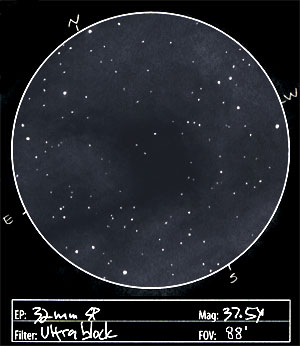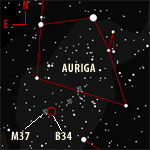
Observation Notes:
 Barnard 34 lies about 1.5 degrees west of M37. Compared to some others I tried to locate earlier, including Barnard 5, this one was easy to spot. For a dark nebula. It appeared as a very soft hole in the Milky Way starlight behind it. The main body of the nebula covered about 1/4 to 1/3 of the view, which amounts to a span of 22′-30′. Bill Ferris came over for a look, and mentioned that he noticed a fan-like appearance to the left side, that I hadn’t noticed yet. After spending some time on it, I began to notice a couple dark spokes running to the northeast and east. The huge number of stars I wanted to plot really tested my patience. I was itching to shade in the Milky Way region around the nebula, but I did my best to keep a lid on it until the star framework was finished. The structures in the sketch can be compared with photography of the region that can be found here.
Barnard 34 lies about 1.5 degrees west of M37. Compared to some others I tried to locate earlier, including Barnard 5, this one was easy to spot. For a dark nebula. It appeared as a very soft hole in the Milky Way starlight behind it. The main body of the nebula covered about 1/4 to 1/3 of the view, which amounts to a span of 22′-30′. Bill Ferris came over for a look, and mentioned that he noticed a fan-like appearance to the left side, that I hadn’t noticed yet. After spending some time on it, I began to notice a couple dark spokes running to the northeast and east. The huge number of stars I wanted to plot really tested my patience. I was itching to shade in the Milky Way region around the nebula, but I did my best to keep a lid on it until the star framework was finished. The structures in the sketch can be compared with photography of the region that can be found here.
| Subject | Barnard 34 |
| Classification | Dark Nebula |
| Position* | Auriga [RA: 05:43:30 / Dec: +32:39:00] |
| Size* | 20′ |
| Dark Rating* | 4 |
| Date/Time | February 24, 2006 – 9:30 PM (February 25, 2006 – 04:30 UT) |
| Observing Loc. | Cinder Hills Overlook, Sunset Crater National Monument, AZ |
| Instrument | Orion SVP 6LT Reflector (150 mm dia./1200 mm F/L) |
| Eyepieces/Mag. | 32 mm (37.5X) |
| Conditions | Clear, calm |
| Seeing | 3-4/10 |
| Transparency | Mag 6.8 NELM |
| Sources | SAC Best of Barnard’s Dark Nebulae List; Barnard’s Photographic Atlas of Selected Regions of the Milky Way |
*Based on published data.